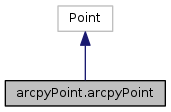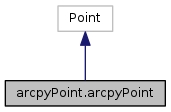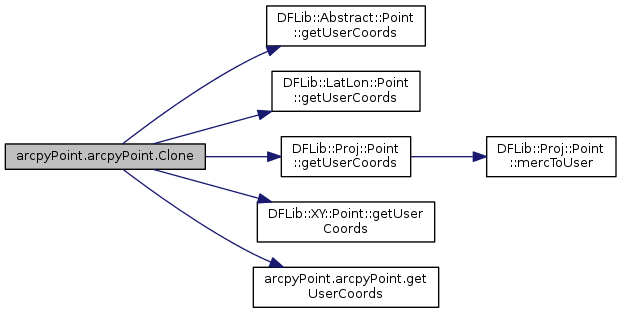Inheritance diagram for arcpyPoint.arcpyPoint:

Collaboration diagram for arcpyPoint.arcpyPoint:

Public Member Functions | |
| def | __init__ (self, sr, args) |
| def | setXY (self, aPosition) |
| def | getXY (self) |
| def | Clone (self) |
| def | getUserCoords (self) |
| def | setUserCoords (self, uPosition) |
Public Attributes | |
| myXY | |
| myUserCoords | |
| myUserSR | |
| myMercatorSR | |
Detailed Description
The "arcpyPoint" class derives from the DFLib::Abstract::Point interface, and implements its interface methods
Constructor & Destructor Documentation
| def arcpyPoint.arcpyPoint.__init__ | ( | self, | |
| sr, | |||
| args | |||
| ) |
arcpyPoint constructor
Member Function Documentation
| def arcpyPoint.arcpyPoint.Clone | ( | self | ) |
Create a new object that is an exact copy of this one in every way. Typically used only by the Fix Cut Average computation routine, but can be used to generate new objects as needed without knowing what type they are.
Here is the call graph for this function:

| def arcpyPoint.arcpyPoint.getUserCoords | ( | self | ) |
Return a vector of coordinates of this point in a user coordinate system (which may be different from the XY coordinate system used for computation of fixes).
Here is the caller graph for this function:

| def arcpyPoint.arcpyPoint.getXY | ( | self | ) |
Return a pointer to the point's internal XY vector (an STL vector of doubles). In C++ implementations, we return a const reference, not a pointer, to prevent changing the position by direct manipulation of the vector. I don't know how to do that in python to prevent abuse of the vector. It should be used only to *query* the position, never to change it. Do NOT use this to change the location of the point.
Here is the caller graph for this function:

| def arcpyPoint.arcpyPoint.setUserCoords | ( | self, | |
| uPosition | |||
| ) |
Set the position of this point using a vector or list of coordinates in the user coordinate system.
Here is the call graph for this function:

| def arcpyPoint.arcpyPoint.setXY | ( | self, | |
| aPosition | |||
| ) |
given a vector (or list) set the location of this point in X-Y coordinates.
Here is the caller graph for this function:

Member Data Documentation
| arcpyPoint.arcpyPoint.myMercatorSR |
| arcpyPoint.arcpyPoint.myUserCoords |
| arcpyPoint.arcpyPoint.myUserSR |
| arcpyPoint.arcpyPoint.myXY |
The documentation for this class was generated from the following file:
- /users/russo/DFLIB_Git/DFLib/Python/arcpyPoint.py
 1.8.9.1
1.8.9.1